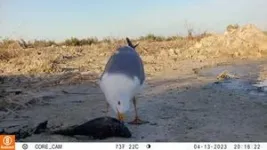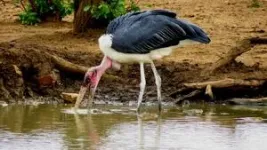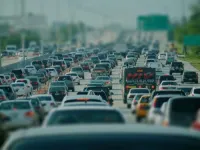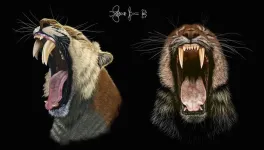(Press-News.org) As a result, the researchers recommend updating the information requirements in the EU legislation, REACH. They also propose various approaches for evaluating chemical substances to ensure that all available information is fully utilized.
Researchers from DTU National Food Institute and the University of Southern Denmark have screened the scientific literature for the Danish Environmental Protection Agency to find substances showing signs of endocrine disrupting properties and thus being potentially harmful to humans and the environment. The results of the study have been published in a new report from the Center for Endocrine Disrupters (CeHoS). In the study, the researchers found a widespread lack of data, especially regarding environmental effects. The researchers emphasize that this lack of data is deeply problematic.
"The study shows that there is a great need to update the information requirements in the EU regulation, REACH, to include information on endocrine disrupting properties," says Marie Louise Holmer, special consultant at DTU National Food Institute and co-author of the report.
Data should be optimally utilized
In the EU, it is highly prioritised to minimize human and environmental exposure to endocrine disrupting substances. However, data reported by companies under EU legislation on industrial chemicals, REACH, rarely contain information that can be used to assess whether the substances are endocrine disrupting in the environment. For 70% of the more than 26,000 industrial chemicals used in various products, there is also no information available to assess whether the substances are endocrine disrupting for humans.
Therefore, the researchers recommend that all available information should be utilized to the fullest extent using two approaches:
1. By assessing similar substances in groups
2. By using knowledge of harmful effects across species.
Nine substances with signs of endocrine disrupting properties
The new study builds upon a report from CeHoS from 2018, which identified a basislist of 171 substances. In the new study, the basislist is expanded to 192 substances. The 192 substances are filtered down to 97 focus substances through a series of exclusion criteria. 10 focus substances are selected for a literature screening.
"The literature screening shows signs of endocrine disrupting properties for 9 out of 10 substances. The question is how it looks for the remaining 87 focus substances," says Sofie Christiansen, senior researcher at DTU National Food Institute and co-author of the report.
The researchers behind the study emphasize that this is only an initial screening of the literature and that a more thorough assessment of the available data is needed before final conclusions can be made.
Cross-species knowledge and grouping of substances can increase our understanding.
Since data scarcity is so widespread, the data available for individual chemicals should be utilized to the fullest extent. Therefore, researchers from DTU National Food Institute and the University of Southern Denmark emphasize that we should use all existing knowledge about endocrine disrupting properties of substances, whether it's humans, fish, amphibians, or rodents that have been studied.
"The effects in animals and humans may be different, but they originate from the same impact on the endocrine system, so the effects we see, for example in fish studies, may also be concerning for humans," says Henrik Holbech, associate professor at the Department of Biology at the University of Southern Denmark and co-author of the report.
Using these new approaches, researchers examined a group of benzophenones used as UV filters in cosmetics and sunscreens. The researchers created a heatmap, providing information on the substances' potentially endocrine disrupting properties across the group and across species. The heatmap can be used to assess where more tests are needed and which substances are similar enough to be evaluated together.
"By looking across when chemical substances resemble each other and including knowledge across species, we utilize the available information to the fullest extent. This is important as our study also shows that there is a lack of knowledge about the endocrine disrupting properties of the majority of substances around us" says Marie Louise Holmer.
About endocrine disrupting substances
Endocrine disrupting substances are causing increasing concern for both human health and environmental impact. In the population, endocrine disrupting substances are suspected to contribute to fertility problems, obesity, cancer, and the development of diabetes, as well as disruptions in brain development and function. Suspected endocrine disrupting substances can be found in products such as cosmetics, clothing, toys, food, and medicines. Several of these substances also end up in the environment, where they can affect fish, amphibians, and other animals and are suspected of contributing to species loss and reduced biodiversity.
About CeHoS
The Center for Endocrine Disrupters (CeHoS) is a center without walls, established in 2008 to build knowledge about the effects of endocrine disrupting substances on humans and the environment and advise authorities in their preventive work in the field. It is a collaboration between Rigshospitalet, DTU, and SDU. With the establishment of the center, a bridge has been built between research environments and authorities, allowing new research results to be quickly translated into knowledge targeted at the work of the authorities.
Find more information about CeHoS on the center's website (in Danish).
Facts
Read the full report: Prioritisation of Endocrine Disruptors for Regulation, CeHoS-5.3: https://cehos.dk/files/ED-list_II_2024.pdf
The project was commissioned by the Danish Environmental Protection Agency and carried out under the auspices of the Center for Endocrine Disrupters.
DTU National Food Institute mainly contributes to the scientific part of the report, which deals with the possible effects of substances on humans. In parallel, the University of Southern Denmark primarily contributes to the scientific knowledge about the potential impact of substances on wildlife.
The study is based on literature reviews and reviews of the regulation and use of chemical substances.
Authors: Marie Louise Holmer, Sofie Christiansen, and Marta Axelstad Petersen from DTU National Food Institute, as well as Henrik Holbech, Jane Ebsen Morthorst, and Karin Lund Kinnberg from the Department of Biology, University of Southern Denmark.
Read about the Research Group for Molecular and Reproductive Toxicology and the Theme of Chemical exposure on the DTU National Food Institute's website.
Read about the Ecotoxicology Group at the University of Southern Denmark
END
Data scarcity challenges identification of endocrine disruptors
Lack of data from the chemical industry in the EU often prevents the assessment of whether substances, for example, used in consumer products, are endocrine disrupting
2024-04-30
ELSE PRESS RELEASES FROM THIS DATE:
A significant portion of the world’s population continues to trust vaccines, says survey in 23 countries
2024-04-30
A substantial proportion of the world’s population remains willing to get vaccinated against diseases including COVID-19, according to a new survey across 23 countries that represent more than 60% of the world’s population. The study, published in Nature Medicine, was co-led by the Barcelona Institute for Global Health (ISGlobal), a centre supported by “la Caixa” Foundation, and the Graduate School of Public Health and Health Policy of the City University of New York (CUNY SPH).
The severe human impact of the COVID-19 pandemic led to the rapid research and development of safe and effective vaccines based on existing models, ...
Clumps of this molecule inhibit strep’s DNA-cleaving enzymes
2024-04-30
An entirely new approach to inhibiting DNA-cleaving enzymes works through the aggregation of an otherwise non-toxic molecule. This Kobe University discovery may lead to a much-needed method for curbing Streptococcus growth.
Enzymes are the body’s tools to make almost all reactions happen. But the same is true for bacteria like Streptococcus, which causes toxic shock syndrome, a rapidly progressing and deadly condition. When the body’s white blood cells try to capture the bacteria by casting nets made out ...
Cars as particles
2024-04-30
What do the flow of cars on a highway and the movement of bacteria towards a food source have in common? In both cases, annoying traffic jams can form. Especially for cars, we might want to understand how to avoid them, but perhaps we've never thought of turning to statistical physics, as Alexandre Solon, a physicist from Sorbonne Université, and Eric Bertin, from the University of Grenoble, both working for the Centre national de la recherche scientifique CNRS, have done. Their research, recently published in the Journal of Statistical Mechanics: Theory and Experiment (JSTAT), has developed a one-dimensional mathematical model ...
Let widgeongrass be a weed in the seagrass yard -- making seagrass restoration more resistant to rising temperatures using generalist grasses
2024-04-30
New research demonstrates that seagrass habitat restoration can be enhanced by including other grasses in addition to the declining or lost species and – ultimately – that restoration efforts must proactively select species that can withstand current and intensifying stressors driven by human activities and climate change.
Rising global temperatures combined with centuries of humans working within our seascapes has reshaped coastal ecosystems. Rebuilding or restoring coastal habitat is becoming ...
Group sales incentives boost weak brand sales, study finds
2024-04-30
New research co-authored by a UC Riverside business professor provides some sound advice for managers of retail outlets that limit their product selection to a particular brand: Managers should factor in the strength of their brand when structuring the pay incentives for their sales staff.
The study focused on what marketing scholars call “brand-managed” retail operations. These outlets include “stores within stores,” such as counters in major department stores with dedicated sales staff that offer just one brand of cosmetics such as Clinique. They can also be stores ...
The double-fanged adolescence of saber-toothed cats
2024-04-30
The fearsome, saber-like teeth of Smilodon fatalis — California's state fossil — are familiar to anyone who has ever visited Los Angeles' La Brea Tar Pits, a sticky trap from which more than 2,000 saber-toothed cat skulls have been excavated over more than a century.
Though few of the recovered skulls had sabers attached, a handful exhibited a peculiar feature: the tooth socket for the saber was occupied by two teeth, with the permanent tooth slotted into a groove in the baby tooth.
Paleontologist Jack Tseng, associate professor of integrative biology at the University of California, Berkeley, doesn't think the double fangs ...
COVID-19-induced financial hardships reveal mental health struggles
2024-04-30
When COVID-19 caused significant economic disruptions, thousands of people around the world experienced sudden shocks to their financial situation through reduced earnings or job losses.
Now economic researchers at the University of South Australia have examined the mental health effects on people who experienced immediate or expected financial setbacks during the height of the pandemic.
Data gathered from China, Japan and South Korea during the early phases of the pandemic revealed that the severe economic shocks induced by COVID-19 caused significant ...
Healthy lifestyle may offset effects of life-shortening genes by 60%+
2024-04-30
A healthy lifestyle may offset the effects of life-shortening genes by more than 60%, suggests an analysis of the findings from several large long term studies, published online in the journal BMJ Evidence Based Medicine.
While genes and lifestyle seem to have an additive effect on a person’s lifespan, an unhealthy lifestyle is independently linked to a 78% heightened risk of dying before one’s time, regardless of genetic predisposition, the research indicates.
The polygenic risk score (PRS) combines ...
Frequent teen vaping might boost risk of toxic lead and uranium exposure
2024-04-30
Frequent teen vaping might boost the risk of exposure to lead and uranium, potentially harming brain and organ development, suggests research published online in the journal Tobacco Control.
The findings underscore the need for implementation of regulations and prevention efforts targeting teens, emphasise the researchers.
Vaping is popular with teens. In 2022, an estimated 14% of US high school students—around 2.14 million—and more than 3% of middle school students—around 380,000—reported vaping in the preceding month, note the researchers.
Certain metals have been identified in e-cigarette aerosols and ...
Fentanyl inhalation may cause potentially irreversible brain damage, warn doctors
2024-04-30
Inhaling the synthetic opioid fentanyl may cause potentially irreversible brain damage (toxic leukoencephalopathy), warn doctors in the journal BMJ Case Reports, after treating a middle aged man found unresponsive in his hotel room after snorting the drug.
Leukoencephalopathy refers to inflammation and damage to the brain’s white matter—the network of nerve fibres that enable the exchange of information and communication between different areas of the brain’s grey matter.
Toxic leukoencephalopathy is a sudden or longstanding neurological syndrome, which ...
LAST 30 PRESS RELEASES:
Tracing the quick synthesis of an industrially important catalyst
New software sheds light on cancer’s hidden genetic networks
UT Health San Antonio awarded $3 million in CPRIT grants to bolster cancer research and prevention efforts in South Texas
Third symposium spotlights global challenge of new contaminants in China’s fight against pollution
From straw to soil harmony: International team reveals how biochar supercharges carbon-smart farming
Myeloma: How AI is redrawing the map of cancer care
Manhattan E. Charurat, Ph.D., MHS invested as the Homer and Martha Gudelsky Distinguished Professor in Medicine at the University of Maryland School of Medicine
Insilico Medicine’s Pharma.AI Q4 Winter Launch Recap: Revolutionizing drug discovery with cutting-edge AI innovations, accelerating the path to pharmaceutical superintelligence
Nanoplastics have diet-dependent impacts on digestive system health
Brain neuron death occurs throughout life and increases with age, a natural human protein drug may halt neuron death in Alzheimer’s disease
SPIE and CLP announce the recipients of the 2025 Advanced Photonics Young Innovator Award
Lessons from the Caldor Fire’s Christmas Valley ‘Miracle’
Ant societies rose by trading individual protection for collective power
Research reveals how ancient viral DNA shapes early embryonic development
A molecular gatekeeper that controls protein synthesis
New ‘cloaking device’ concept to shield sensitive tech from magnetic fields
Researchers show impact of mountain building and climate change on alpine biodiversity
Study models the transition from Neanderthals to modern humans in Europe
University of Phoenix College of Doctoral Studies releases white paper on AI-driven skilling to reduce burnout and restore worker autonomy
AIs fail at the game of visual “telephone”
The levers for a sustainable food system
Potential changes in US homelessness by ending federal support for housing first programs
Vulnerability of large language models to prompt injection when providing medical advice
Researchers develop new system for high-energy-density, long-life, multi-electron transfer bromine-based flow batteries
Ending federal support for housing first programs could increase U.S. homelessness by 5% in one year, new JAMA study finds
New research uncovers molecular ‘safety switch’ shielding cancers from immune attack
Bacteria resisting viral infection can still sink carbon to ocean floor
Younger biological age may increase depression risk in older women during COVID-19
Bharat Innovates 2026 National Basecamp Showcases India’s Most Promising Deep-Tech Ventures
Here’s what determines whether your income level rises or falls
[Press-News.org] Data scarcity challenges identification of endocrine disruptorsLack of data from the chemical industry in the EU often prevents the assessment of whether substances, for example, used in consumer products, are endocrine disrupting







